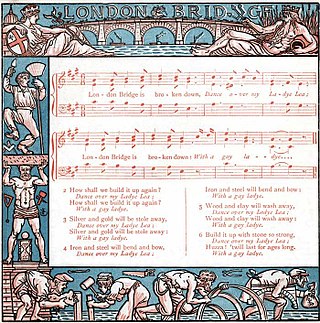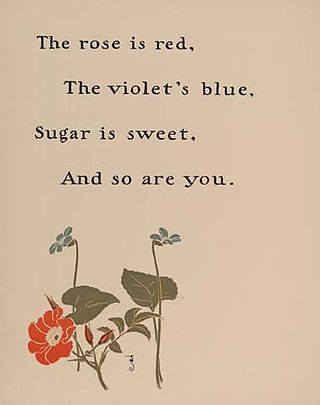Origins
The first surviving version of the rhyme was published in Infant Institutes, part the first: or a Nurserical Essay on the Poetry, Lyric and Allegorical, of the Earliest Ages, &c., in London around 1797. [1] It also appears in Mother Goose's Quarto: or Melodies Complete, printed in Boston, Massachusetts around 1825. [1] A verse collected from Aberdeen, Scotland and published in 1868 had the words:
Peter, my neeper,
Had a wife,
And he couldna' keep her,
He pat her i' the wa',
And lat a' the mice eat her.
This verse is also considered to be an older version of the rhyme Eeper Weeper. [2]

A nursery rhyme is a traditional poem or song for children in Britain and many other countries, but usage of the term dates only from the late 18th/early 19th century. The term Mother Goose rhymes is interchangeable with nursery rhymes.

Humpty Dumpty is a character in an English nursery rhyme, probably originally a riddle and one of the best known in the English-speaking world. He is typically portrayed as an anthropomorphic egg, though he is not explicitly described as such. The first recorded versions of the rhyme date from late eighteenth-century England and the tune from 1870 in James William Elliott's National Nursery Rhymes and Nursery Songs. Its origins are obscure, and several theories have been advanced to suggest original meanings.

The figure of Mother Goose is the imaginary author of a collection of French fairy tales and later of English nursery rhymes. As a character, she appeared in a song, the first stanza of which often functions now as a nursery rhyme. This, however, was dependent on a Christmas pantomime, a successor to which is still performed in the United Kingdom.

"Little Bo-Peep" or "Little Bo-Peep has lost her sheep" is a popular English language nursery rhyme. It has a Roud Folk Song Index number of 6487.

"Georgie Porgie" is a popular English language nursery rhyme. It has the Roud Folk Song Index number 19532.

"London Bridge Is Falling Down" is a traditional English nursery rhyme and singing game, which is found in different versions all over the world. It deals with the dilapidation of London Bridge and attempts, realistic or fanciful, to repair it. It may date back to bridge-related rhymes and games of the Late Middle Ages, but the earliest records of the rhyme in English are from the 17th century. The lyrics were first printed in close to their modern form in the mid-18th century and became popular, particularly in Britain and the United States, during the 19th century.

"Jack Sprat" is an English language nursery rhyme. It has a Roud Folk Song Index number of 19479.

"Ring a Ring o' Roses", "Ring a Ring o' Rosie", or "Ring Around the Rosie", is a nursery rhyme, folk song and playground singing game. Descriptions first emerge in the mid-19th century, but are reported as dating from decades before, and similar rhymes are known from across Europe. It has a Roud Folk Song Index number of 7925.

"Roses Are Red" is the name of a love poem and children's rhyme with Roud Folk Song Index number 19798. It has become a cliché for Valentine's Day, and has spawned multiple humorous and parodic variants.
A children's song may be a nursery rhyme set to music, a song that children invent and share among themselves or a modern creation intended for entertainment, use in the home or education. Although children's songs have been recorded and studied in some cultures more than others, they appear to be universal in human society.

"Ding Dong Bell" or "Ding Dong Dell" is a popular English language nursery rhyme. It has a Roud Folk Song Index number of 12853.

"There was an Old Woman Who Lived in a Shoe" is a popular English language nursery rhyme, with a Roud Folk Song Index number of 19132. Debates over its meaning and origin have largely centered on attempts to match the old woman with historical female figures who have had large families, although King George II (1683–1760) has also been proposed as the rhyme's subject.

The Lion and the Unicorn are symbols of the United Kingdom. They are, properly speaking, heraldic supporters appearing in the full royal coat of arms of the United Kingdom. The lion stands for England and the unicorn for Scotland. The combination therefore dates back to the 1603 accession of James I of England who was already James VI of Scotland. By extension, they are also used in the arms of Newfoundland since 1637, the arms of Hanover between 1837–1866, and the arms of Canada since 1921.

"Tom, Tom, the Piper's Son" is a popular English language nursery rhyme. It has a Roud Folk Song Index number of 19621.
"Cock a Doodle Doo" is an English language nursery rhyme.
Iona Margaret Balfour Opie, and Peter Mason Opie were an English married team of folklorists who applied modern techniques to understanding children's literature and play, in studies such as The Oxford Dictionary of Nursery Rhymes (1951) and The Lore and Language of Schoolchildren (1959). They were also noted anthologists, assembled large collections of children's literature, toys, and games and were regarded as world-famous authorities on children's lore and customs.
"I Love Little Pussy", alternatively called "I Love Little Kitty", is an English language nursery rhyme about a person who is kind to a pet cat. It has a Roud Folk Song Index number of 12824.
"Eeper Weeper" or "Heeper Peeper" is a popular English nursery rhyme and skipping song that tells the story of a chimney sweep who kills his second wife and hides her body up a chimney. The rhyme has a Roud Folk Song Index number of 13497.

"Round and round the garden" is an English language nursery rhyme typically accompanied by fingerplay. It has a Roud Folk Song Index number of 19235.
"Girls and Boys Come Out to Play" or "Boys and Girls Come Out to Play" is a nursery rhyme that has existed since at least 1708. It has a Roud Folk Song Index number of 5452.














